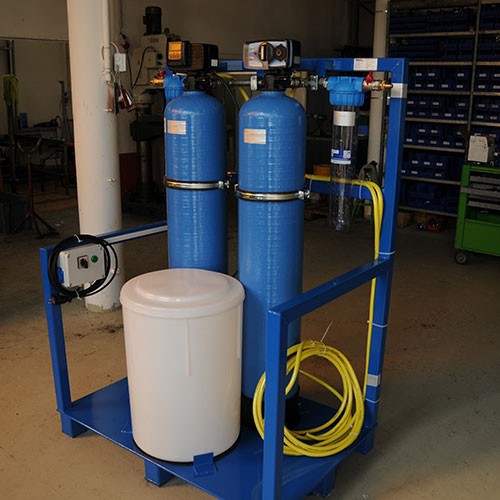Operation of a softening unit

Well and spring waters contain so-called hardness formers, which have been dissolved out of the rock. In the German-speaking world, 1° dH (1 German degree of hardness) was introduced as the standard for water hardness. Water with
- 0 - 6 degrees dH is called soft,
- 6 - 12 degrees dH moderately hard,
- 12 - 18 degrees dH hard and
- 18 degrees and more dH as very hard.

In trade and industry, but also in the household sector, pipe networks, appliances and equipment that come into contact with water must be protected from hardness that is known in the form of "limestone". Nowadays, this is done almost without exception by so-called softening units, which remove the hardness components from the raw water and replace them with harmless sodium ions. This process is carried out by so-called ion exchange media.
The ion exchange mass in the pressure tanks of softening units consists of synthetic resin beads with a diameter of 0.3 to 1.2 mm, the porous structure of which has a very large, exchange-active surface.
The absorption capacity of the ion exchange mass for the hardness components to be removed from the raw water is, of course, limited. If the capacity is exhausted after a certain amount of water has flowed through, regeneration must be carried out with saline solution, whereby the ion exchange mass is charged again with sodium ions. During this process, the previously deposited hardness formers flow off with the regeneration water into the sewage system.
This process can be repeated as often as desired. After each regeneration, a certain exchange capacity is available again, which is expressed in cubic metres x degrees of German hardness. In everyday usage, however, the amount of soft water that can be withdrawn from a system between two regenerations is also often referred to as capacity, although in this case the raw water hardness must be specified.
The capacity of a system depends not only on the quality and quantity of the ion exchanger mass, but also on the type of salting, i.e. the quantity of common salt consumed per litre of ion exchanger during regeneration.
A distinction is made between economy and full salting. From a salting quantity of about 240 g/l exchanger, full salting is given, in order to offer the most effective and cost-effective system possible, we usually design the systems for economy salting. This guarantees low running costs.